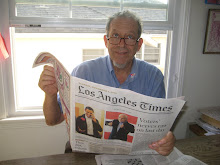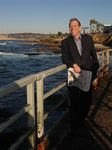No light no sight no time
no space, just void till rhyme
takes me from hell, the Don
who focuses upon
discovering the cause
behind the contradiction
between life and the laws
beyond God’s jurisdiction.
Tour of 'Hell' in Evening Dress
How Charles Laughton taught America to love Shaw
By TERRY TEACHOUT
Before there were regional theaters, there was Charles Laughton. Today most people remember him for having played Quasimodo in "The Hunchback of Notre Dame" and the snarling Captain Bligh in "Mutiny on the Bounty," but between 1949 and 1952 he spent much of his time not in Hollywood but on the road with Charles Boyer, Cedric Hardwicke and Agnes Moorehead.
Billing themselves as the First Drama Quartette, these four middle-age stars barnstormed from coast to coast, performing George Bernard Shaw's "Don Juan in Hell" in sports arenas, banquet halls and civic auditoriums that had never before offered anything more daunting than fluffy farces like "Arsenic and Old Lace." In addition to playing the Devil, Laughton served as master of ceremonies and directed the show, which was seen by a half-million people and was recorded by Columbia Masterworks, a label better known for Bach, Beethoven and Brahms.
The legendary LP version of "Don Juan in Hell" has been out of print for four decades. Now Saland Publishing, an outfit that specializes in audiobooks, has reissued it at last, not as a compact disc but in the ultramodern form of an mp3 file that can be played on a computer or iPod. You can download it from Amazon.com for the paltry sum of $1.98, which buys you not merely 90 minutes of superlative acting but a glimpse of a chapter of American cultural history that ought to be far better remembered.
In the '30s and '40s, Charles Laughton was one of the best-known character actors in the English-speaking world, a fat, rumpled gent whose resplendent bass-baritone voice could make the silliest script sound profound. By 1949, though, Hollywood had stopped giving the 50-year-old Laughton worthy parts, and his career was in decline. Then he went on "The Ed Sullivan Show" and read the biblical tale of how King Nebuchadnezzar threw Shadrach, Meshach and Abednego into a fiery furnace for refusing to bow down before a golden idol. Unlikely as it may sound, Laughton's appearance was typical of the Sullivan show, which regularly made room for actors, ballet dancers and classical musicians along with the pop singers and ventriloquists that were its usual fare.
Network TV was like that in the era of what came to be known as "middlebrow" culture. Back then and for long afterward, you could switch on your set and see a new play by Horton Foote or a lecture by Leonard Bernstein about Beethoven's Fifth Symphony in between sitcoms, just as you could read all about the wide world of art each week in Time and Life. In those days it was taken for granted that the upward mobility of middle-class Americans extended to cultural matters, and that anyone, educated or not, could appreciate highbrow art so long as it was presented in an accessible and engaging way.
Paul Gregory, an up-and-coming young agent, saw Laughton on TV and immediately offered to send him on the road in a one-man show in which the actor would read from the Bible and other works of great literature. Laughton had already paid numerous visits to military hospitals during World War II, and had been struck by the passion with which wounded soldiers responded to such elevated fare. He accepted Gregory's offer, and the resulting show drew packed houses wherever it played.
Laughton and Gregory then cooked up the idea of producing "Don Juan in Hell," the scene from Shaw's "Man and Superman" in which Don Juan, two of his earthly companions and Satan, their host, spend an evening in hell chewing over matters romantic, religious and philosophical ("An Englishman thinks he is being moral when he is only uncomfortable"). It occurred to Gregory that the scene, which is a kind of verbal chamber music, could be "staged" in the same way that a string quartet gives a concert: No set, no props, just four actors in evening dress seated on stools placed behind music stands, reading Shaw's words out loud. Such a show could be mounted almost anywhere at modest expense—and that's just what happened. "Don Juan in Hell" went on the road in 1949, and by the time it got to New York two years later, it had played 500 performances, most of them one-nighters, in 35 states. The touring version brought in gross receipts of more than a million dollars—$8 million today.
The Columbia recording of "Don Juan in Hell," made in 1952, is a breathtakingly vivid souvenir of the original production. Laughton sets the scene by reading Shaw's first stage direction out loud: "No light, no sound, no time nor space, utter void." All at once you're thrust into a darkness of the imagination lit only by the four sharply differentiated voices of the cast: Laughton is unflappably urbane, Boyer amused and seductive, Moorehead stingingly haughty, Hardwicke crisp as Melba toast. What they give us is not so much a play as a conversation piece—the after-dinner chat of four geniuses. Imagine the impact it must have had on audiences in a place like the 12,000-seat Memorial Coliseum in Lexington, Ky., where you could buy a ticket for as little as 20 cents!
Brooks Atkinson, reviewing "Don Juan in Hell" for the New York Times, called it "a mighty and moving occasion, not only a performance but an intellectual crusade." So it was, at least as far as Laughton was concerned. Not only did he believe with all his heart that the plain people of America had what he called a "shy hunger" for great art, but he made it his business to bring it to them, whether on TV or in their local high-school gym—and he made out like a bandit by doing so. But now that middlebrow culture is as dead as Ed Sullivan and most of the mass media have long since given up on paying more than infrequent ritual homage to the power and glory of high art, I can't help but wonder: Who's going to tell the next generation of potential playgoers and concertgoers what they're missing?
—
2/6/10
Saturday, February 6, 2010
Subscribe to:
Post Comments (Atom)


No comments:
Post a Comment